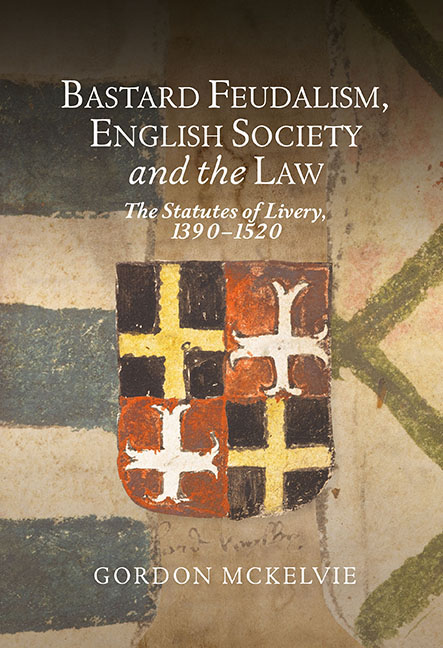Book contents
- Frontmatter
- Contents
- Acknowledgements
- Abbreviations
- Timeline of Parliamentary Activity
- Introduction
- Chapter 1 The System – Liveries and Retaining
- Chapter 2 The Early Years, 1390 to 1449
- Chapter 3 The Later Years, 1449 to 1520
- Chapter 4 Outcomes and Enforcement
- Chapter 5 The Identity of the Indicted
- Chapter 6 The Geography of the Cases
- Chapter 7 Networks and Localities
- Chapter 8 Livery and Disorder
- Chapter 9 The Urban Experience
- Conclusion
- Appendix 1 Number of Cases by Reign
- Appendix 2 Number of Cases in each County
- Appendix 3 List of Letters to Towns and Lordships
- Appendix 4 List of Local Ordinances
- Appendix 5 Letters from Henry VII to Duchy of Lancaster Officials
- Bibliography
- Index
Chapter 3 - The Later Years, 1449 to 1520
Published online by Cambridge University Press: 02 April 2020
- Frontmatter
- Contents
- Acknowledgements
- Abbreviations
- Timeline of Parliamentary Activity
- Introduction
- Chapter 1 The System – Liveries and Retaining
- Chapter 2 The Early Years, 1390 to 1449
- Chapter 3 The Later Years, 1449 to 1520
- Chapter 4 Outcomes and Enforcement
- Chapter 5 The Identity of the Indicted
- Chapter 6 The Geography of the Cases
- Chapter 7 Networks and Localities
- Chapter 8 Livery and Disorder
- Chapter 9 The Urban Experience
- Conclusion
- Appendix 1 Number of Cases by Reign
- Appendix 2 Number of Cases in each County
- Appendix 3 List of Letters to Towns and Lordships
- Appendix 4 List of Local Ordinances
- Appendix 5 Letters from Henry VII to Duchy of Lancaster Officials
- Bibliography
- Index
Summary
The statutes lay dormant for most of the 1440s and re-emerged as a key political issue towards the end of the decade, with new legislation about livery emanating from the crown as opposed to the Commons in parliament. The period examined in this chapter encompasses the violent upheavals of the Wars of the Roses and the development of the ‘New Monarchies’ of the Yorkists and Tudors. These events helped to shape the development and enforcement of the law. A key point to stress throughout this discussion is that no king wanted to destroy the independent power of the English nobility, including Henry VII, whom previous generations of historians believed did have such ambitions. There were more cases from the second half of the fifteenth century, many of which coincided with events of national significance. As with the previous chapter, the focus here remains the relationship between the development of the law in parliament and its enforcement in the localities.
The 1450s
At the Winchester sessions of the 1449 parliament John, Lord Stourton, stated that the problem of liveries along with ‘murders and ryottes don ageinst the peace’ necessitated the issuing of commissions of oyer et terminer throughout England. There is no record of the discussion on the parliament roll because it was part of a discussion in the Lords as opposed to the Commons. Stourton's comments are recorded in a report about ‘a frank and open debate among lords in Parliament itself’ that survives in two seventeenth-century copies that appear to be genuine. The reason why liveries were included along with murders and riots is uncertain, as there were no large-scale private feuds at this point akin to those a few years later between the Percy and the Neville families or the Courtenay and Bonville families. Shortly before this session, there had been the first known case of illegal livery in England for nine years. During Easter 1449, Sir Robert Hungerford was indicted in Hampshire for giving illegal livery to John Rooley, gentleman, from Andover the previous September. Although the Hungerfords were a prominent southern family and the crime was committed close to the location of that parliament, it is unlikely that such a minor case sparked Stourton to claim this.
- Type
- Chapter
- Information
- Bastard Feudalism, English Society and the LawThe Statutes of Livery, 1390–1520, pp. 57 - 80Publisher: Boydell & BrewerPrint publication year: 2020



